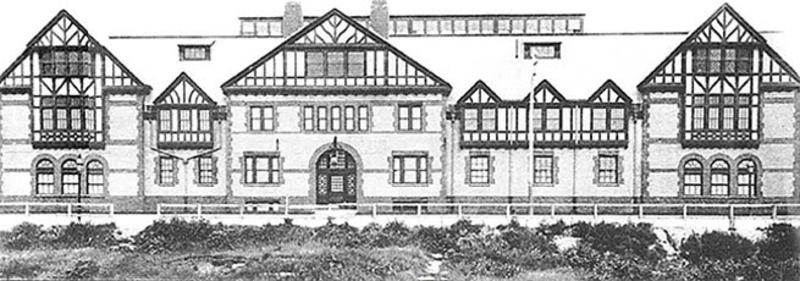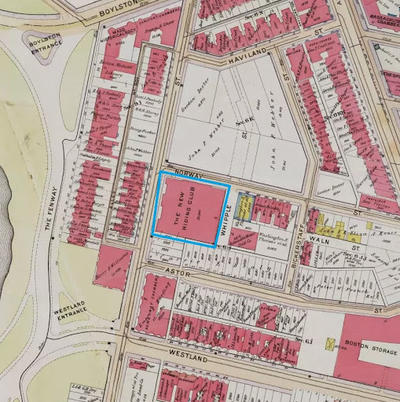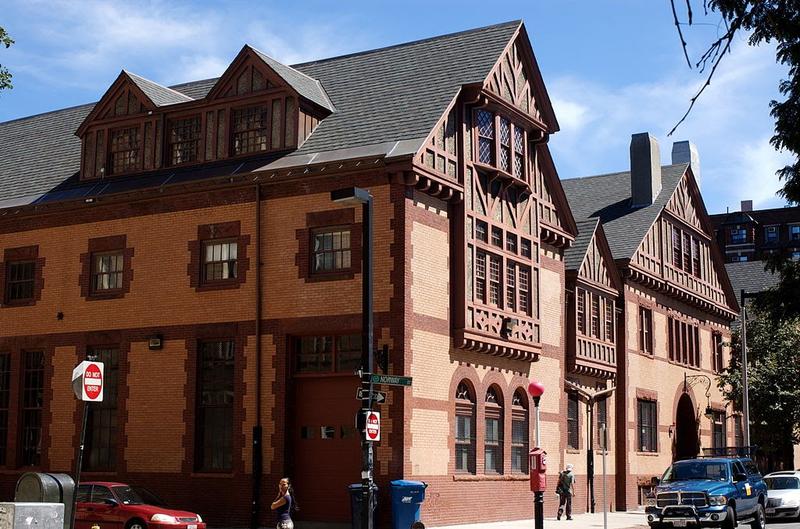Buildings we love: The New Boston Riding Club
The New Riding Club of Boston was built on a site previously occupied by a brick industrial building.
- Architectural style: Tudor Revival
- Year built: 1891-1892
- Architect: Willard T. Sears
- Builder: Woodbury and Leighton
- Original use: Horse Stables
- Date added to the National Register: August 20, 1987
- Protected Boston Landmark or within a Local Historic District: No
The New Riding Club of Boston was built on a site previously occupied by a brick industrial building owned by the Boston Water Power Company when the area around Hemenway Street (then Parker Street) was part of the Gravelly Point cross dam/mill complex. Restrictions on the development of the site for a riding club and horse stable were specified by deed to insure that no entrance for horses or vehicles be erected on Parker Street (Hemenway) and that the southerly wall of the building be erected within one year of September 21, 1891. The Club apparently was not completely finished for several years, and although the 1892 Boston Directory lists The New Riding Club, the organization’s by-laws of 1895 suggest that the building was still under construction. Adjacent to The New Riding Club on Caledonia Street (now Norway Street) during the 1890s was the frame, then stone-fronted, building housing the Neverslip Horse Shoe Co.
Other larger scale stables and riding clubs in the Fenway area at the turn-of-the-century are the Park Riding School at 145-151 Ipswich Street and the Vinal Stables on the corner of Scotia and Bothnia Street, currently a park and St. Cecilia’s Church.
The New Riding Club building included clubhouse facilities, a stable, and a ring and offered services for the grooming, shoeing, feeding, exercising, and veterinary care of member’s horses. The club’s immediate access to The Fens and location in a newly fashionable residential area attracted an elite membership of Boston’s wealthy and socially prominent families. In 1895, members of the New Riding Club included Henry M. Whitney, Robert Treat Paine, A. Lawrence Rotch, and Thomas Bailey Aldrich. Albert G. Baxter, the President of the Club, lived at 144 Huntington Avenue, near West Newton Street and was earlier in life, Superintendent of the Phoenix Copper Mine at Eagle River, Michigan and later, in the lumber manufacturing business in Boston and St. Johns, New Brunswick. Baxter was well known as an avid outdoorsman and was a daily horseback rider.
The August 14, 1891, building permit for the New Riding Club indicates that initially the firm of Cummings and Sears was retained as architects of the building. The firm name however is later crossed-out and replaced with W.T. Sears, 70 Kilby Street. Willard T. Sears (1837-1920) was born and educated in New Bedford and began his design work in Boston in the office of Gridley J.F. Bryant. In the early 1860s he formed a partnership with Charles A. Cummings which enjoyed a successful practice until the dissolution of the firm around 1895. Cummings and Sears were active in the rebuilding of Boston’s commercial area after the 1872 Fire and were the architects of the Bedford building (Bedford & Franklin) in 1874. The firm was responsible during the 1870s and 1880s for many Back Bay residences, including 49-51 Commonwealth, 112-117 Commonwealth, 165 Commonwealth, 132 Commonwealth, and the partners own residences at 109 Newbury Street and 322 Marlborough Street. Cummings and Sears also designed the New Old South Church in Copley Square and the Cyclorama Building at 541 Tremont Street. Willard T. Sears is well-known as the architect of Fenway Court for Isabella Steward Gardner and for apartment buildings in Back Bay, such as 416 Marlborough Street and The Cambridge at 483 Commonwealth Avenue.
Woodbury and Leighton, a major contracting firm in the Boston area and builders of the New Riding Club, were in charge of the construction for several landmark buildings including the Boston Public Library, the First Church of Christ Scientists, The International Trust Building, and the Boston YWCA.
Today the structure is currently The Badminton & Tennis Club.




